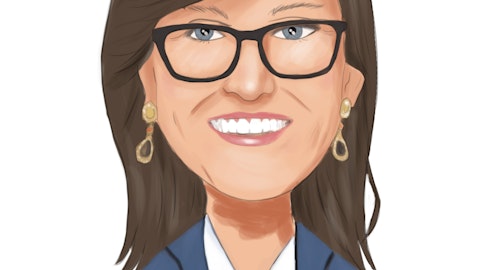Kabir Nath: We’re certainly seeing more than single patients. Some of the sites, it’s still quite early. And the earliest sites have got going pretty well. And we will wait to see exactly how the run rate picks up over the next few weeks. As I tried to explain, it is early in the setup where there are delays and where new sites have difficulty coming to terms with things. But we’re pretty confident that those who’ve got up earliest and who are most experienced is showing a good run rate.
Charles Duncan: That’s helpful. And then moving on to the PTS, the open-label study data yet this year given that it’s open-label signal seeking, what would you see as a win? Surely, you’re not looking for a p-value or anything like that, but I’m quite intrigued with this. So interested to know what would encourage you to call it operationalize and next step?
Kabir Nath: Well, it’s a safety study. So acceptability will be the number question, just how well it went for the patients, how well it went to the therapies. The second issue is, obviously, we look at effect sizes of the response in the secondary measures we’re making, particularly the measures of trauma memory. And what we will do is obviously compare that with existing studies we can look across to the MAP study, much as it’s difficult to do that with different trials. It’s too tempting, and we’ll be making decisions on the basis of what we find. So, we’re looking forward to doing that next year.
Charles Duncan: Could you anticipate operationalizing a study next year in PTSD?
Dr. Guy Goodwin: So as we’ve said, we are very focused on our TRD program but also completing PTSD and anorexia. But clearly, if we see a strong signal, we are always driven by unmet needs in the science, and we will consider a strategy for how we might take that forward. But there are no decisions at this point.
Charles Duncan: And the cash guide through 05 or mid — not ’05, excuse me, 25%. Does that contemplate a study Kabir, or would that be a difference of thinking?
Mary-Rose Hughes: Yes. So that’s virtually 2025, it doesn’t contemplate a further study. We would consider that as [Indiscernible]. If evidence of promising, but not right now.
Operator: Our next question comes from François Brisebois with Oppenheimer.
François Brisebois: Just a couple of them. You said that you’ve been discussing with sites about potentially switching or also allowing COMP360 down the road at sites that currently have Spravato that delivers Spravato. How are those discussions going? What potential pushback could there be from sites?
Kabir Nath: So as I said, I mean, in principle, the premise we’re taking in is that anyone who has delayed today delivering Spravato for patients with treatment-resistant depression, should first be very interested in potentially delivering COMP 360 for the same population, but also have clearly taken steps around establishing physical settings that could be appropriate for COM360. Clearly, the economics are delivering these 2 are very different. So just as a reminder, Esketamine label and administrations in the first month for in the second and that after required fairly frequent administrations, but it’s a shorter duration of time in the clinic with the monitoring period. With COM360, we’re obviously looking at something that is a longer session on the day of dosing, but much less frequent.
So part of the work we’re doing is we engage with these is to really get a deep understanding of the practice economics and ensure that the appropriate incentives are in place to make it feasible for these places not only to treat with Spravato but also with CO360. And of course, it’s in that context that the work we did on the CBT 3 code is so important.
François Brisebois: And then can you help us understand, economically for its centre and maybe that’s evolving, but is it more practical or profitable to have multiple sessions, but then maybe have some holes between sessions or to have a longer session with one patient. What makes more sense economically for the centre?



